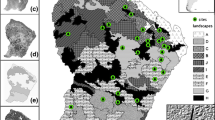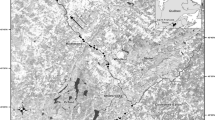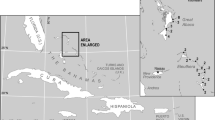Abstract
The goal of this study was to identify and characterize the range of variation in riparian forests across Lower Michigan, USA as a basis for assessing the utility of map-based information in the characterization of riparian environments. We obtained a regional sample of riparian forests and valley-bottom physiography from 94 locations throughout Lower Michigan and distinguished seven major riparian forest types using hierarchical clustering and NMDS ordination. NMDS ordination distances accounted for more than 70% of the distances in species space and achieved excellent discrimination among riparian types. We then evaluated a set of map-based variables indicative of regional climate, catchment hydrology, and valley character relative to ordination axes and interpretations of the autecology of principal tree species from each forest group. Map-based predictors accounted for 83% of the variation in sample scores along NMDS Axis 1 and explained 42% of the variation in Axis 2. Species and riparian types varied along two principal gradients, one associated with climate and geology along a north-south gradient, the second associated with flood duration and power. Map-based interpretations of regional climate and hydroperiod dynamics agreed closely with species-based interpretations of riparian character, although in certain cases, a similar biotic response arose from apparently distinct hydrogeomorphic contexts. Such dynamic patterns underscore the need for better and more explicit linkages between the controls of riparian hydrology and more proximal physical cues on biotic communities in order to understand the drivers of spatial variation in riparian ecosystem structure and composition.
Similar content being viewed by others
Literature Cited
Albert, D. A., S. R. Denton, and B. V. Barnes. 1986. Regional Landscape Ecosystems of Michigan. School of Natural Resources, University of Michigan, Ann Arbor, MI, USA.
Baker, M. E. and B. V. Barnes. 1998. The landscape ecosystem diversity of river floodplains in Northwestern Lower Michigan. Canadian Journal of Forest Research 28:1405–1418.
Baker, M. E., M. J. Wiley, and P. W. Seelbach. 2001. GIS-based hydrologic modeling of riparian areas: implications for stream water quality. Journal of the American Water Resources Association 37:1615–1628.
Baker, M. E., M. J. Wiley, P. W. Seelbach, and M. L. Carlson. 2003. A GIS-model of subsurface water potential for aquatic resource inventory, assessment, and environmental management. Environmental Management 32:706–719.
Baker, W. L. 1989. Macro- and micro-scale influences on riparian vegetation in western Colorado. Annals of the Association of American Geographers 79:65–78.
Barnes, B. V. and W. H. Wagner, Jr. 1981. Michigan Trees: a Guide to the Trees of Michigan and the Great Lakes Region. University of Michigan Press. Ann Arbor, MI, USA.
Barnes, W. J. 1985. Population dynamics of woody plants on a river island. Canadian Journal of Botany 63:647–655.
Barnes, W. J. 1997. Vegetation dynamics on the floodplain of the lower Chippewa River in Wisconsin. Journal of the Torrey Botanical Society 124:189–197.
Bedient, P. B. and W. C. Huber. 1989. Hydrology and Floodplain Analysis. Addison Wesley, New York, NY, USA.
Bendix, J. 1994. Among-site variation in riparian vegetation of the Southern California Transverse Ranges. American Midland Naturalist 132:136–151.
Bendix, J. and C. R. Hupp. 2000. Hydrological and geomorphological impacts on riparian plant communities. Hydrological Processes 14:2977–2990.
Brown, S. and D. L. Peterson. 1983. Structural characteristics and biomass production of two Illinois bottomland forests. American Midland Naturalist 11:107–117.
Buell, M. E. and W. A. Wistendahl. 1955. Floodplain forests of the Raritan River. Bulletin of the Torrey Botanical Club 82:463–472.
Clarke, K. R. 1993. Non-parametric multivariate analysis of changes in community structure. Australian Journal of Ecology 18:117–143.
Cole, C. A. and R. P. Brooks. 2000. Patterns of wetland hydrology in the ridge and valley province, Pennsylvania, USA. Wetlands 20:438–447.
Crow, T. R., M. E. Baker, and B. V. Barnes. 2000. Diversity in riparian landscapes. p. 43–66. In E. S. Verry, J. W. Hornbeck, and C. A. Dolloff (eds.) Riparian Management in Forests of the Continental Eastern U. S. Lewis Publishers, New York, NY, USA.
Dollar, K. E., S. G. Pallardy, and H. G. Garret. 1992. Composition and environment of floodplain forests of northern Missouri. Canadian Journal of Forest Research 22:1343–1350.
Dufrene, M. and P. Legendre. 1997. Species assemblage and indicator species: the need for a flexible asymmetrical approach. Ecological Monographs 67:345–366.
Dunn, C. P. and F. Sterns. 1987. A comparison of vegetation and soils in floodplain and basin forested wetlands of southeastern Wisconsin. American Midland Naturalist 118:374–383.
Farrand, W. R. and D. Bell. 1982. Quaternary geology of Michigan. State of Michigan Department of Natural Resources, Geological Survey, Lansing, MI, USA. Color Map.
Frye, R. J. and J. A. Quinn. 1979. Forest development in relation to topography and soils on a floodplain of the Raritan River, New Jersey. Bulletin of the Torrey Botanical Club 106:334–345.
Gregory, S. V., F. J. Swanson, W. A. McKee, and K. W. Cummins. 1991. An ecosystem perspective of riparian zones: focus on the links between land and water. Bioscience 41:540–551.
Hardin, E. D., K. P. Lewis, and W. A. Wistendahl. 1989. Gradient analysis of floodplain forests along three rivers in unglaciated Ohio. Bulletin of the Torrey Botanical Club. 116:258–264.
Harris, R. R. 1987. Occurrence of vegetation on geomorphic surfaces in the active floodplain of a California alluvial stream. American Midland Naturalist 118:393–05.
Harris, R. R. and C. Olsen. 1997. Two-stage system for prioritizing riparian restoration at the stream reach and community scales. Restoration Ecology 5:34–42.
Hauer, F. R. and R. D. Smith. 1998. The hydrogeomorphic approach to functional assessment of riparian wetlands: evaluating impacts and mitigation on river floodplains in the U.S.A. Freshwater Biology 40:517–530.
Hosner, J. F. and L. S. Minckler. 1963. Bottomland hardwood forests of southern Illinois. Ecology 44:29–41.
Hupp, C. R. 1982. Stream-grade variation and riparian-forest ecology along Passage Creek, Virginia. Bulletin of the Torrey Botanical Club 109:488–499.
Hupp, C. R. and W. R. Osterkamp. 1985. Bottomland vegetation distribution along Passage Creek, Virginia in relation to fluvial landforms. Ecology 66:670–681.
Johnson, W. C. 2000. Tree recruitment and survival in rivers: influence of hydrological processes. Hydrological Processes 14:3051–3074.
Junk, W. J., P. B. Bayley, and R. E. Sparks. 1989. The flood-pulse concept in river floodplain systems. Canadian Special Publications in Fisheries and Aquatic Sciences 106:110–127.
Kearsley, J. 1999. Inventory and vegetation classification of floodplain forest communities in Massachusetts. Rhodora 101:105–135.
Lapin, M. and B. V. Barnes. 1995. Using the landscape ecosystem approach to assess species and ecosystem diversity. Conservation Biology 9:1148–1158.
Lindsey, A. A., R. O. Petty, D. K. Sterling, and W. Van Adsall. 1961. Vegetation and environment along the Wabash and Tippecanoe rivers. Ecological Monographs 37:105–156.
Magurran, A. E. 1988. Ecological Diversity and Its Measurement. Princeton University Press. Princeton, NJ, USA.
McCune, B. and M. J. Mefford. 1999. PC-ORD: multivariate analysis of ecological data, Version 4. MjM Software Design, Gleneden Beach, OR, USA.
Nelson, J. C. and R. E. Sparks. 1998. Forest compositional change at the confluence of the Illinois and Mississippi Rivers. Transactions of the Illinois State Academy of Science 91:33–46.
Nilsson, C., A. Ekblad, M. Dynesius, S. Backe, M. Gardfjell, B. Carlberg, S. Hellqvist, and R. Jansson. 1994. A comparison of species richness and traits of riparian plants between a main channel and its tributaries. Journal of Ecology 82:281–295.
Nilsson, C. and G. Grelsson. 1995. The fragility of ecosystems: a review. Journal of Applied Ecology 32:677–692.
O’Neill, M. P., J. C. Schmidt, J. P. Dobrowolski, C. P. Hawkins, and C. M. U. Neale. 1997. Identifying sites for riparian wetland restoration: application of a model to the upper Arkansas River Basin. Restoration Ecology 5:85–102.
Russell, G. D., C. P. Hawkins, and M. P. O’Neill. 1997. The role of GIS in selecting sites for riparian restoration based on hydrology and land use. Restoration Ecology 5:56–68.
Schumm, S. A. 1977. The Fluvial System. John Wiley and Sons, New York, NY, USA.
Sneath, P. H. A. and R. R. Sokal. 1973. Numerical Taxonomy. W. H. Freeman Publishers, San Francisco, CA, USA.
Tabacchi, E., A. M. Planty-Tabacchi, M. Jacoba Salinias, and H. Decamps. 1996. Landscape structure and diversity in riparian plant communities: a longitudinal comparative study. Regulated Rivers Research and Management 12:367–390.
Taylor, S. 1972. Ecological and genetic isolation of Eraxinus americana and Fraxinus pennsylvanica. Ph. D. Dissertation. University of Michigan. Ann Arbor, MI, USA.
Townsend, P. 2001. Relationships between vegetation patterns and hydroperiod on the Roanoke River floodplain, North Carolina. Plant Ecology 156:43–58.
Voss, E. G. 1972. Michigan Flora. Part I. Gymnosperms and Monocots. University of Michigan, Ann Arbor, MI, USA.
Voss, E. G. 1985. Michigan Flora Part II. Dicots. University of Michigan, Ann Arbor, MI, USA.
Voss, E. G. 1996. Michigan Flora. Part III. Dicots concluded. University of Michigan, Ann Arbor, MI, USA.
Ward, J. V. and J. A. Stanford. 1995. The serial discontinuity concept: extending the model to floodplain rivers. Regulated Rivers Research and Management 10:159–168.
Author information
Authors and Affiliations
Corresponding author
Rights and permissions
About this article
Cite this article
Baker, M.E., Wiley, M.J. Characterization of woody species distribution in riparian forests of Lower Michigan, USA using map-based models. Wetlands 24, 550–561 (2004). https://doi.org/10.1672/0277-5212(2004)024[0550:COWSDI]2.0.CO;2
Received:
Revised:
Accepted:
Issue Date:
DOI: https://doi.org/10.1672/0277-5212(2004)024[0550:COWSDI]2.0.CO;2




